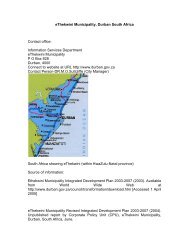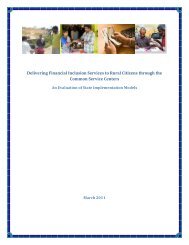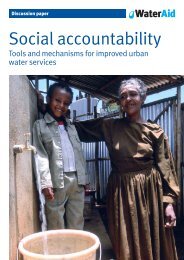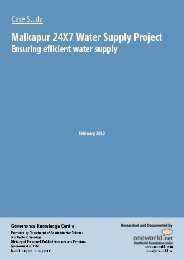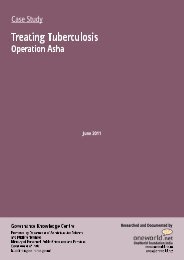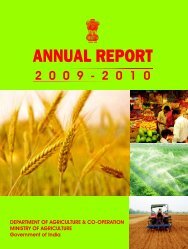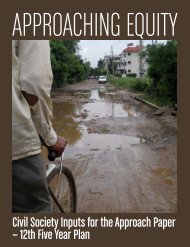Assistive technologies and the education system in India
Assistive technologies and the education system in India
Assistive technologies and the education system in India
Create successful ePaper yourself
Turn your PDF publications into a flip-book with our unique Google optimized e-Paper software.
Independent Text Read<strong>in</strong>g: The bl<strong>in</strong>d <strong>and</strong> low vision students today are dependent onvoluntarily readers <strong>and</strong> are able to barely manage to study <strong>the</strong>ir textbooks but due toacute shortage of human readers <strong>the</strong>se days, <strong>the</strong> problems have multiplied. However,with <strong>the</strong> use of Text Read<strong>in</strong>g mach<strong>in</strong>es, like <strong>the</strong> K1000 OCR read<strong>in</strong>g software, whichus<strong>in</strong>g a PC <strong>and</strong> scanner convert any pr<strong>in</strong>ted text <strong>in</strong>to sound <strong>and</strong> magnify <strong>the</strong> text for lowvision on a St<strong>and</strong>ard TV/ monitor, or even provide support for read<strong>in</strong>g, writ<strong>in</strong>g <strong>and</strong>study<strong>in</strong>g for dyslexic [learn<strong>in</strong>g disabled] <strong>the</strong>y can simply borrow any book from <strong>the</strong>library <strong>and</strong> read <strong>the</strong> same <strong>in</strong>dependently <strong>and</strong> Prisma pr<strong>in</strong>t magnifier connected to a 21<strong>in</strong>ch TV or monitor for low vision.Audio devices: Along with Braille materials <strong>and</strong> computers, visually impaired personsprefer to use audio materials <strong>in</strong> <strong>the</strong>ir studies. They use various cassette players <strong>and</strong>o<strong>the</strong>r record<strong>in</strong>g mach<strong>in</strong>es for different purposes; to record <strong>the</strong> lectures, books <strong>and</strong> studymaterials <strong>and</strong> to submit <strong>the</strong>ir assignments <strong>in</strong> audio formats. Now-a- days, talk<strong>in</strong>g booksare available <strong>in</strong> different formats which can be listened with some sophisticated audiodevices. Generally <strong>the</strong> audio cassettes <strong>and</strong> CDs are used for prepar<strong>in</strong>g talk<strong>in</strong>g books forpeople with visual impairment. In <strong>the</strong> advancement of technology, this process ofprepar<strong>in</strong>g talk<strong>in</strong>g books becomes easier day by day.The traditional audio guides <strong>and</strong> CDs are arranged <strong>in</strong> a l<strong>in</strong>ear sequence of tracks. Theseare designed ei<strong>the</strong>r to play <strong>in</strong> a complete sequence from beg<strong>in</strong>n<strong>in</strong>g to end, but usually<strong>the</strong>y play a s<strong>in</strong>gle track at a time, <strong>the</strong>n wait for <strong>the</strong> user to select ano<strong>the</strong>r track. The tracksare usually identified, for example by number, at <strong>the</strong> <strong>in</strong>formation posts located besideeach artifact. The user can enter <strong>the</strong> number <strong>and</strong> listen to <strong>the</strong> appropriate audio. Butnow-a-days <strong>the</strong> DAISY format plays a great role as an advanced audio device <strong>in</strong> <strong>the</strong> fieldof <strong>education</strong>. The DAISY format is similar, but <strong>in</strong>troduces a more sophisticated level ofnavigation. Instead of a simple series of tracks, <strong>the</strong> content is arranged <strong>in</strong> a series ofchapters, each conta<strong>in</strong><strong>in</strong>g a number of sections, which can also conta<strong>in</strong> sub-sections.Audio <strong>in</strong>formation can be synchronized with <strong>the</strong> transcript. However, <strong>the</strong> DAISY formatwas orig<strong>in</strong>ally designed to be held on a CD-ROM, but is by no means limited to thismedium. As memory becomes cheaper, <strong>and</strong> more capacious but physically smaller,DAISY content no longer has to be held on CD-ROM but can also be held on hard-drivememory. Hence an <strong>in</strong>creas<strong>in</strong>g number of bl<strong>in</strong>d people now have <strong>the</strong>ir own DAISYformat players, which give <strong>the</strong>m access to enter<strong>in</strong>g <strong>and</strong> read<strong>in</strong>g text.In today’s world, <strong>the</strong> bl<strong>in</strong>d learners use various digital sound recorders for <strong>the</strong>ir studypurpose. These digital sound recorders can help <strong>the</strong> visually impaired persons to record<strong>the</strong> lectures. These are portable devices <strong>and</strong> very easy to operate. Digital sound recordershave made <strong>the</strong> learn<strong>in</strong>g process of <strong>the</strong> people with visual impairments easier. So, <strong>the</strong>se




